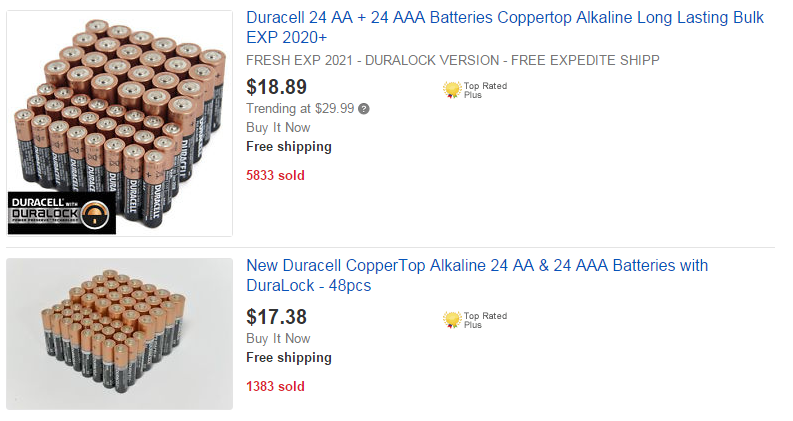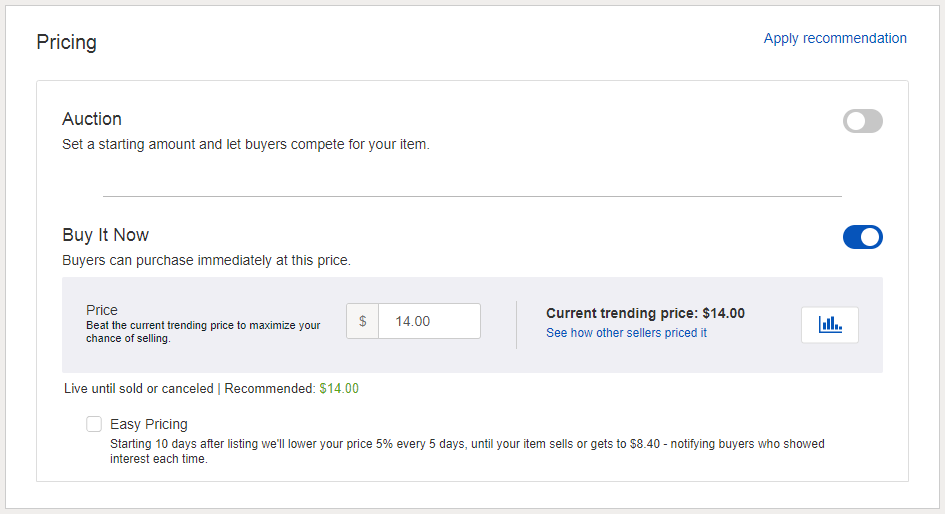So, you’ve learned the basics of eBay selling and how to keep your feedback score high, and you’ve sold a couple of used things from around your house. You have the lay of the land. Now it’s time to start really making money selling on eBay.
But where do you begin? How do you turn eBay from a way to clear out your garage into a steady source of income?
It turns out it’s easier than you might think. You just need to know two things:
Fully updated 1/10/2018.
1. How to Determine Whether a Product Can Make Money on eBay
As we cover in "Selling on eBay for Beginners," the first thing you need to understand is eBay fees. Between eBay and PayPal, selling through a basic free listing will cost you 12.9% of the total price you charge your customer (including shipping) plus $0.30.
Note: Sellers who use eBay-managed payments will pay 12.7% instead.
You have to determine if what you want to sell will make a profit despite those costs. Here’s how to do that in five steps:
Step 1. Identify a Competitive Price
When considering buying something to resell on eBay, you first need to review its going price. One way is to search manually. Let’s take a look at a pack of 24 AA and 24 AAA Duracell batteries:
It looks like this pack generally costs $29.99. However, the two listings above popped up almost immediately when I typed in “batteries.” Since they come from Top Rated Plus sellers and include free shipping, there’s no reason why a buyer wouldn’t just grab these excellent bargains immediately.
In a case like this, I wouldn’t try to sell these unless I could turn a profit by selling them at $18 or less with free shipping. I have to compete with these guys on price or nobody will buy from me.
eBay has also added another way to gauge a competitive price: trending prices.
Trending prices appear when you use the eBay's quick listing tool. eBay will recommend a selling format (auction or fixed price) and either a starting bid or a price. You can easily switch the format and change the price if desired.
As pictured above, you'll see the current trending price or average starting bid, which eBay will automatically enter for you. Plus, you can click "See how other sellers priced it" to see a list of recently successful prices for the same item. This is a fast and easy way to figure out how much you can charge for a product.
To start creating a listing and access these recommendations, log in to your eBay account, then click "Sell." On the next page, if you see "Business tool" in the upper right, you're already using the quick listing tool. If not, you may need to click "Switch to quick listing tool" (also in the upper right).
Step 2. Set a Minimum Acceptable Profit
Determine how much you need to make on each sale to make it worth your time.
For the batteries, $5 is the minimum profit I would accept for the amount of work I’m putting in. After subtracting $2.62 in eBay fees from the $18 price I set in step 1, the cost of the batteries and shipping combined would have to be less than $15.38 for me to turn any profit. I’d therefore want the costs to be no more than $10 so I’m not making slave wages.
Step 3. Determine Shipping Costs
If you want to offer free shipping, determine your shipping costs. The eBay Shipping Calculator makes this easy.
You'll also need to package the item for shipping. In general, a small item costs at least a dollar to package. See "Packaging Costs for Selling Online" for details.
Quick tip: Shipping makes items like these batteries a poor choice for most sellers. Because they are large and heavy, the cost of shipping can be high, and most customers will prefer to purchase them from brick-and-mortar stores. Small, light items generally sell best on eBay.
Step 4. Decide How Much You’ll Pay

Subtract the shipping costs, the eBay fees, and your minimum acceptable profit from the competitive price. The remainder is how much you can afford to spend on the item you want to sell.
Let’s say I found a way to ship these batteries for $6 and package them for $1.50. I would then combine the $6 in shipping, $1.50 in packaging, $2.62 in eBay fees, and $5 in minimum acceptable profit to get a total of $15.12. Subtract that from the $18 I determined to be a competitive price and my budget to buy each pack of batteries is $2.88.
That’s highly unlikely to happen with this particular product. However, you’re much more likely to turn a good profit from less competitive products. Lower competition means that customers have fewer options and will therefore be willing to pay a higher price.
Step 5. See If You Can Buy the Item That Cheaply
Now that you know how much you can spend on a product and still make a worthwhile profit, you need to find someone who will sell it to you at that low price. That brings us to the second thing you need to know:
2. How to Find a Source of Products
In order to create a sustainable business, you must have a steady stream of products to sell. Consider the following options:
Option 1. Buying Local

Maybe where you live has something unique to sell. Perhaps you’re a Vermonter with neighbors who sell maple syrup for a low price. Maybe you know some traditional craftsmen who make things you can’t find in other places.
In any case, if you can source things that other people have a harder time locating, you might be able to sell them on eBay for a profit.
The great things about this option are that:
- You get to deal with your supplier face-to-face.
- You’re supporting local business.
- You can develop a steady stream of income.
Option 2. Sourcing from Wholesalers and Manufacturers
This may be the most reliable option: Find a wholesaler or get directly in touch with the company that makes the item you want to sell. They may be willing to sell you something in large quantities for an extremely low price per unit.
You’ll probably get the highest profits per sale by taking this option. However, if you can’t sell the product, you may get stuck with hundreds of dollars of worthless merchandise.
The other downside of this method is that the internet is loaded with fake manufacturers and wholesalers just hoping to scam you out of your money. It’s a good idea to use a reputable wholesale sourcing organization like SaleHoo to avoid the fakes. You can also buy from brick-and-mortar wholesalers like Costco to avoid buying on the web entirely, but these have smaller selections and higher prices.
Option 3. Dropshipping

Another option offered by many manufacturers is dropshipping. With this option, you never buy the product yourself. Instead, you make the eBay listing for an item sold by a manufacturer, then inform them of the customer’s address when someone makes a purchase.
The biggest advantage of this is that you don’t have to pay for the product yourself and you don’t have to deal with storing or shipping it. It has fewer costs and takes much less of your time than option 2.
On the other hand, not all manufacturers provide this service, and not all who do are reliable. Your shipping and handling—and therefore a large part of your customer service—are completely out of your hands. And if your item never makes it to the customer, you take the blame.
Rapid responses to support requests are critical for dropshippers who get left in a lurch by their suppliers. Inform customers immediately when a dropshipping promise falls through, and consider integrating eBay with Zendesk, Freshdesk or Help Scout to better manage your customer support.
Option 4. Bargain Hunting
Store closings and garage sales are good places to find items selling for a fraction of their usual price. Snoop around for good deals, and bring along a smartphone so you can determine if the item will make a profit.
You can also do this on eBay and other online marketplaces. Look for people who are selling something way below the usual price that you know you can sell for more. Buy from them, then put the item back on eBay from your account.
Want more in-depth info on buying and selling strategies? See our guide to eBay business models.
Summary
The secret to making money selling on eBay can be boiled down to one sentence: Find someone who will sell you something cheaply enough that you can sell it for a profit at a competitive price. That’s really all it takes. Now get out there and start selling!






